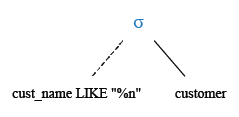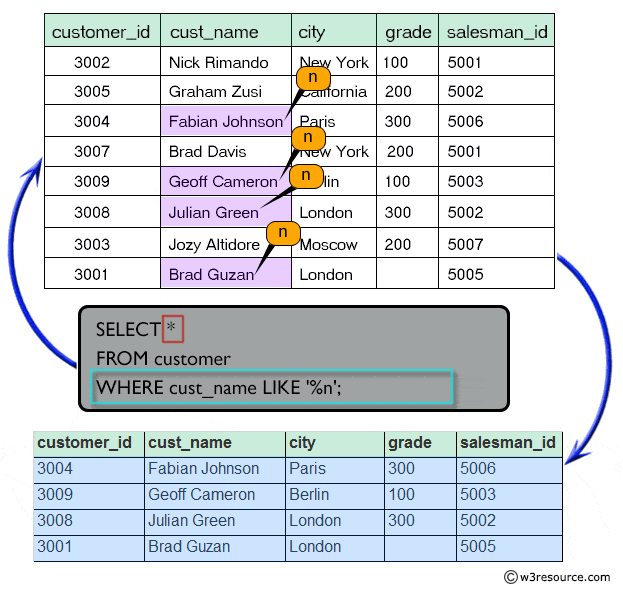SQL Exercises: Filtering records with where clause and like operator
10. Customers with Names Ending with N
From the following table, write a SQL query to find the details of the customers whose names end with the letter 'n'. Return customer_id, cust_name, city, grade, salesman_id.
Sample table: customer
customer_id | cust_name | city | grade | salesman_id
-------------+----------------+------------+-------+-------------
3002 | Nick Rimando | New York | 100 | 5001
3007 | Brad Davis | New York | 200 | 5001
3005 | Graham Zusi | California | 200 | 5002
3008 | Julian Green | London | 300 | 5002
3004 | Fabian Johnson | Paris | 300 | 5006
3009 | Geoff Cameron | Berlin | 100 | 5003
3003 | Jozy Altidor | Moscow | 200 | 5007
3001 | Brad Guzan | London | | 5005
Sample Solution:
-- This query selects all columns from the 'customer' table.
SELECT *
-- Specifies the table from which to retrieve the data (in this case, 'customer').
FROM customer
-- Filters the rows to only include those where the 'cust_name' column contains the letter 'n' at the end.
WHERE cust_name LIKE '%n';
Output of the Query:
customer_id cust_name city grade salesman_id 3008 Julian Green London 300 5002 3004 Fabian Johnson Paris 300 5006 3009 Geoff Cameron Berlin 100 5003 3001 Brad Guzan London 5005
Code Explanation:
The said SQL query selects all columns (*) from the 'customer' table where the value of the "cust_name" column ends with the letter 'n' .
The '%' is a wildcard character in SQL, which can match any string of any length (including an empty string).
The 'LIKE' operator is used to search for a specific pattern in a column.
Relational Algebra Expression:
Relational Algebra Tree:
Explanation :
Visual presentation :
Go to:
PREV : Customers with Names Starting with B.
NEXT : Salespeople Name Starts 'N' with Fourth 'L'.
Practice Online
For more Practice: Solve these Related Problems:
- Write a SQL query to find the details of customers whose names end with the letter 'd'. Return customer_id, cust_name, city, grade, salesman_id.
- Write a SQL query to retrieve the details of customers whose names start with the letter 'F'. Return customer_id, cust_name, city, grade, salesman_id.
- Write a SQL query to find the details of customers whose names contain the letter 'e'. Return customer_id, cust_name, city, grade, salesman_id.
- Write a SQL query to list all customers whose names have exactly 5 letters. Return customer_id, cust_name, city, grade, salesman_id.
Contribute your code and comments through Disqus.
What is the difficulty level of this exercise?
Test your Programming skills with w3resource's quiz.




